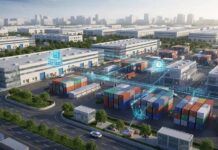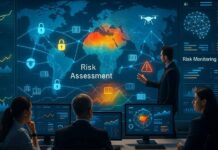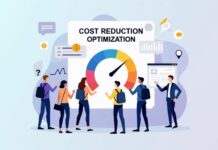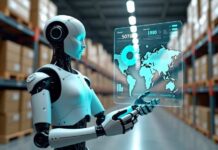In today’s fast-changing global market, automation and AI are transforming the supply chain business. Companies may automate their supply chains using innovative technology to improve service, save costs, and boost product availability. Since companies were trying to keep up with labor shortages, changing consumer demands, and logistical disruptions during the pandemic, automation and AI adoption reduced costs and increased product availability. Automation and AI are changing the supply chain, producing new logistical trails, and the future of international commerce. The Industrial Automation and Control Systems Market is expected to reach USD 864.94 Billion by 2031 from USD 379.47 Billion in 2023 and USD 413.87 Billion in 2024, growing at a CAGR of 10.8%.
1. Automation: Cutting Human Intervention and Improving Accuracy
Automation technology reduced human influence, ensured an error-free supply chain, and improved operational efficiency, redefined supply chain management. Fully-automated retail warehouses using robotic systems can select, pack, sort, and palletize with accuracy and speed. Modern warehouses are powered by autonomous mobile robots (AMRs) and automated guided vehicles (AGVs), which eliminate man/labor input and human mistakes. Amazon and Walmart have used robots in facilities to speed up and improve order fulfillment. Sorting and packaging items is most efficient using modern conveyor systems and robots. Automation can sort goods by size, weight, and destination to ensure proper packaging and labeling. Reduced bottlenecks help organizations to handle more orders faster. AI-enhanced RFID sensors and inventory automation eliminate human stock checks. AI, RFID, and barcodes allow organizations to monitor inventory levels in real time, preventing overstocking or understocking. In this method, automated controls re-order stock without the management’s interaction, saving the warehouse manager time on inventory counts. Supply chain transportation is automated too. First-mile autonomous trucks, drones, and delivery robots are beginning to pioneer inclusive logistics by eliminating human driver reliance and speeding up logistical processes. Shipping giants UPS and FedEx are exploring these ideas to improve service and decrease costs.
2. Using AI to Make Better Decisions
AI is transforming supply chain automation by enabling data-driven decision-making. AI has proven most prevalent in supply chain transportation. AI in the supply chain helps companies understand demand, arrange smart routes, and manage risk in decision-making.
Companies are using predicted sale machine tools with AI to better identify demand changes. Machine learning algorithms can anticipate demand using previous sales, consumer behavior patterns, and external variables like weather and economic trends to improve production schedules and distribution tactics. This reduces stock-outs and inventory values, improving the supply chain.
Real-time traffic, weather, and delivery data is being used to evaluate artificial intelligence systems for transportation and delivery. Logistic businesses may reduce fuel usage, accelerate delivery, and meet delivery time using such algorithms. AI-based route mapping is crucial for organizations with complex networks or distributors that deliver to consumers last.
AI adds intelligence to sourcing departments to streamline supplier selection, contract administration, and risk assessment. Machine learning algorithms evaluate supplier performance before they get to market, or they estimate geological and political hazards. The algorithms then recommend ways to source quicker, minimize supply chain vulnerability, and lessen supplier disruption issues.
AI-controlled inventory systems may automatically buy missing items based on real-time customer demand and store inventory levels. Thus, operations always have a specified stock, lowering stock-carrying costs and eliminating unnecessary stock.
3. How AI Improves Supply Chain Transparency
The biggest supply chain management problems should be transparency and visibility. AI technologies provide consumers a complete picture of operations and the finest recipes from start to finish without visual or network bandwidth issues:
AI platforms can monitor
of the supply chain, from raw material procurement to final delivery, quick and allows time zone-based shipping status, inventory levels, and production timetables. These platforms aggregate data from IoT devices, sensors, and logistics management systems to provide enterprises a realistic view of their supply chain operations.
AI and blockchain are strong. Their intersection is advantageous yet underappreciated in logistics. The unified supply chain benefits from AI and blockchain. Blockchain offers a distributed ledger that can only process incoming transactions, and AI may evaluate this data to find misunderstandings and verify product legitimacy and rules. This blend applies mostly to pharmaceutical, food & beverage, and luxury manufacturing industries where detecting altered or damaged goods is crucial.
AI is transforming risk avoidance by analyzing data from multiple sources to identify disruptions and determine mitigation strategies. To clarify, AI algorithms may assess supplier bankruptcy, natural disasters, and political upheaval to help corporations alter their sourcing plans. Intelligent companies construct flexible, robust supply networks that can withstand disasters.
4. AI and Cobots in Human-Augmented Operations
One of the biggest supply chain management concerns is logistical network visibility and transparency. AI solutions provide end-to-end visibility and real-time supply chain information to solve these issues: The logistics network’s lack of openness and transparency is one of the experts’ biggest concerns. AI’s end-to-end supply chain technology solves supply chain visibility and real-time analytics issues.
From raw material procurement to customer delivery, AI-enabled solutions can manage shipping updates, inventory levels, and manufacturing timetables quickly. IoT devices, sensors, and logistics management systems allow company owners to aggregate data and observe their supply chain in real time. AI and blockchain technologies greatly increase supply chain traceability and transparency. Blocks are immutable recordings in blockchain. Companies can quickly discover irregularities, verify product authenticity, and comply with regulations using AI. This combination is especially beneficial for pharmaceutical, food and beverage, and luxury products companies that prioritize product reputation and safety.
AI’s multi-source data analytics technology predicts upcoming problems and suggests strategies to handle them, elevating risk management. For instance, AI systems can assess risks like supplier insolvency, natural disasters, and political unrest, allowing organizations to make timely choices to protect supply chains and maintain operations. High insight speeds up company action, which may spontaneously handle bad circumstances. While automation is reducing manual labor in certain sectors, cobots are also using AI-enhanced applications from a human perspective, which is second to manned operation in worker safety:
Cobots are designed for the workers, but robots cannot fully automate. These robots can load or unload heavy equipment, assemble items, and match processes while humans execute more sophisticated and value-added jobs. AI-powered vision sensors allow cobots to adapt to varied surroundings and interact with humans. Artificial intelligence safety-sensor systems are being incorporated into supply chain processes to monitor worker conditions and identify possible hazards. AI-powered security cameras and sensors may detect risky behavior or environmental conditions and inform personnel or take automatic steps to prevent mishaps. Companies may create safe working conditions and reduce workplace injuries this way.
5. The Future of Supply Chain Automation and AI
Massive automation and AI advances will drive the supply chain management revolution. These will be the main developments in future years: Enterprise supply chains now achieve “zero human touches” with hyper-automation, which combines AI, RPA, and machine learning. These technologies will help businesses adapt to shifting market circumstances and grow. A fully autonomous AI supply network is the future vision. These intelligent systems will configure, heal, and govern themselves, eliminating the need for human supervision.
Autonomous supply chains may adjust production schedules depending on pending orders, existing production, warehouse occupancy, and demand. They instantly identify business-killing requirements. AI is the key to sustainable supply chains by maximizing resource consumption, eliminating waste, and lowering carbon emissions. AI simulations helped design eco-friendly shipping, reusing, and recycling items, lowering supply chain net carbon emissions.
Conclusion
Automation and AI may transform industry with higher competence, reduced costs, and improved decision-making. Integrating artificial intelligence and computer technology solutions is helping organizations make better choices by constructing more intelligent, robust supply networks than the global market needs. AI and robots will aid the creation of completely automated, transparent supply chains, the foundation of future logistics.

























